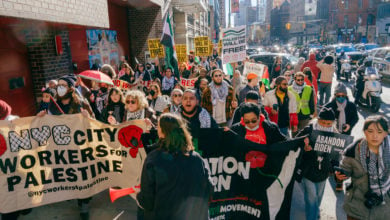The rich are getting richer while the people are getting poorer. Forbes just announced, as it does every year, the status of the richest Americans. The richest 400 individuals this year hold 13 percent of the entire wealth of a society of 300 million people. Their wealth increased by 7 percent just since this year, and their average personal wealth is $4.2 billion. Mitt Romney would be way too poor to join the club since he is only “worth” $250 million.
Meanwhile, over the last year, millions more workers were plunged into poverty, and lost their pensions and health care. When adjusted for inflation, workers’ wages are lower than they were 40 years ago. The minimum wage in 2012 is 22 percent lower—in real dollars—than it was in 1972. Millions of young workers cannot find jobs and cannot pay their extortionate debt to the banks.
Return to a golden era?
Faced with the grim present, many liberals and progressives often look back to a period of relative affluence in the United States, from the 1950s to the mid-1970s.
After World War II, the working class in Europe and the United States experienced an expansion of wages and increased living standards. The social safety net was expanded, labor unions grew in both size and influence, manufacturing boomed, and a high rate of taxation on the rich restrained inequality.
This was the era of the stereotypical white picket fence, when many workers became homeowners, moved to the suburbs and began to enjoy disposable income. What is typically missing from this rosy picture is that Black, Latino, Asian and Native people were largely segregated and excluded from these benefits.
In addition, much of the “comfortable” American lifestyle was premised on the complete U.S. domination of the global capitalist economy. The U.S. dollar became the world reserve currency, and the military launched interventions and wars, and the CIA organized coups to strengthen the position and profits of U.S. corporations. The U.S. ruling class promoted an ideology of American superiority and threw some crumbs to the workers to buy their loyalty.
This is not the sort of golden era to which progressive people should aspire.
Social programs and the class struggle
The social insurance programs that exist in Western Europe and in the United States did not come about only because society enjoyed a relative affluence in the recovery years after World War II. In the United States, mass radical workers’ struggles in the 1930s won Social Security, unemployment insurance and other previously non-existent benefits. Parallel movements took place across Latin America in the 1930s and achieved similar gains.
The capitalist ruling classes of Western Europe and Japan expanded the social safety net because of global competition with the Soviet Union and other socialist countries. The Soviet Union and the governments of Eastern Europe provided the masses of people previously unheard-of social rights, including the rights to a job, free health care and affordable housing; extensive vacation time; and the ability to retire at a relatively early age without fear of impoverishment.
In that sense, the expansion of the social safety net in the capitalist countries was a direct benefit achieved by the working classes through the global class struggle between capitalism and socialism.
In the 1980s and 1990s, the destruction of the Soviet Union and the socialist governments of Eastern and Central Europe provided the capitalists in the West with the opportunity to reverse course. It eliminated the political need to offer extensive social insurance programs for the unemployed, low-income people and the working class.
‘New normal’ not so new
The mainstream media says that the current economy—of lower wages, mass unemployment and the loss of benefits and pensions—represents the “new normal” as U.S. workers are forced to compete with their counterparts internationally for jobs.
But, actually, the new normal is not new. In the last few decades, the advanced capitalist economies have returned to the norms that existed prior to World War II.
Before World War II, the working classes in Europe and the United States experienced recurrent periods of mass unemployment and impoverishment of large sections of the population. The working class in general lived a precarious existence and typically earned a subsistence wage—just enough to survive on. There were few job protections, and a worker who was sick or elderly, and thus could not earn a wage, was forced to rely on charity or starve.
The government blatantly served big business. Labor unions were demonized, and workers feared that any form of struggle would lead to their firing and replacement. Sounds familiar, doesn’t it? The current period is not an exact copy of that era, elements of the social safety net remain, and workers today can live somewhat beyond their wage because of limited access to cheap credit. But the direction of the current era is clear. The “new normal” is a reversion to the historic normal of the capitalist mode of production.
Karl Marx wrote extensively on the subject of these basic features of capitalism. In “Capital,” he wrote of the “general law” of the system to establish an “accumulation of misery, corresponding with accumulation of capital. Accumulation of wealth at one pole is, therefore, at the same time accumulation of misery, agony of toil, slavery, ignorance, brutality, mental degradation, at the opposite pole; i.e., on the side of the class that produces its own product in the form of capital.”
Marx did not argue that the wages and conditions of the workers were incapable of improvement. He himself fought fiercely for economic and social reforms. He advocated for the formation of labor unions, which by struggling could improve wages, benefits, and the length of the workday, while serving as well as a school for class struggle.
But Marx made clear that the gains won by the working class at one moment, in one era, can be undermined either by economic crisis, inflation in prices or an assault waged by the bosses during periods of high unemployment, which increased competition among workers for scarce jobs.
Contrary to the assertions of those who advocate class collaboration, Marx exposed that the benefits achieved by the working class were only based on its struggle, not mutual “sharing” of the benefits of capital accumulation.
Short of exceptional circumstances, such as the temporary abundance that existed in the imperialist countries immediately after World War II, the norm of capitalism is to drive the working class into greater misery.
Whenever the capitalists make high profits, they use those revenues to invest in new machinery and technology to replace the workers who made such profits possible. They use the profits to set up factories where profits can be maximized, which is where wages are lowest—either outside of the United States or in low-wage areas in the United States.
This pattern of cutting wages, and slashing benefits and pensions is not the work of a particularly evil capitalist or group of capitalists. It is the dominant trend of capitalism as a system.
Class struggle or class collaboration?
The difference between the European labor movement and the U.S. labor movement could not be starker.
While the labor movement in Europe was in the streets or preparing for a magnificent day of mass action, the top U.S. labor leaders were meeting in the White House with President Obama to hear about and give their feedback on U.S. government plans to impose austerity on the working class, the poor and elderly.
Of course, the leadership of the AFL-CIO, SEIU and other unions are thrilled that they are given access to the White House and to the president. They will take great pride in the fact that the president meets with the labor movement as well as representatives of big business. They will console themselves that labor played an essential role in the reelection of President Obama, and this has given them more access to the government.
Their strategy is exclusively premised on class collaboration rather than struggle against the federal government and Democratic Party. They will tell their members that the administration is pro-labor, and that is why the rich will have to pay slightly higher taxes instead of just having the “middle class” pay.
This is perfectly acceptable to the Obama administration and even to the union-busting, wage-slashing, benefit-cutting capitalists. They would rather have the potentially powerful U.S. labor movement sitting at the table while their benefits are continually cut than mobilizing millions to fight the assault on social programs that benefit the working class, poor and elderly.
The U.S. labor movement, if it were oriented toward struggle rather than class collaboration, would be in a very strong position to initiate a broad-based struggle against austerity. Its credibility would soar among non-unionized workers, and poor and working class communities generally.
Regardless of whether labor rises to the challenge, we can anticipate a period of intense class struggle. Right now, it is largely a one-sided one against the workers, but the last few years have produced new forms of resistance and organization.
As the class struggle renews in the advanced capitalist countries, it is inevitable that socialism will come back as a major force. It remains the only viable alternative to capitalism, a system premised on the accumulation of wealth on one side and misery on the other.






